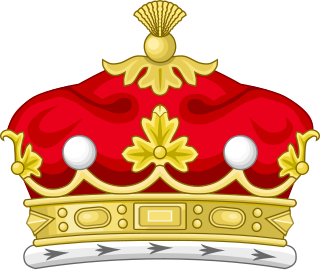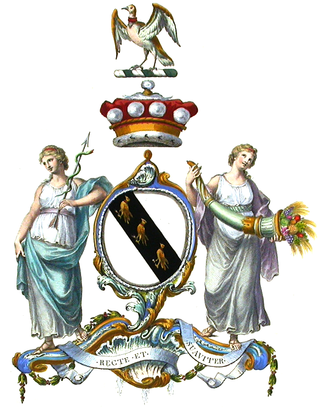Related Research Articles

Marquess of the County of Bute, shortened in general usage to Marquess of Bute, is a title in the Peerage of Great Britain. It was created in 1796 for John Stuart, 4th Earl of Bute.

Viscount Gage, of Castle Island in the County of Kerry of the Kingdom of Ireland, is a title in the Peerage of Ireland. It was created in 1720 for Thomas Gage, along with the subsidiary title of Baron Gage, of Castlebar in the County of Mayo, also in the Peerage of Ireland. In 1744 he also succeeded his cousin as eighth Baronet, of Firle Place. The titles remain united. The Gage family descends from John Gage, who was created a baronet, of Firle Place in the County of Sussex, in the Baronetage of England on 26 March 1622. His great-grandson, the seventh Baronet, represented Seaford in Parliament. He was succeeded by his first cousin, Thomas Gage, 1st Viscount Gage, the eighth Baronet. He sat as a Member of Parliament for Minehead and Tewkesbury and also served as Governor of Barbados. In 1720, 24 years before succeeding in the baronetcy, he was raised to the Peerage of Ireland as Baron Gage and Viscount Gage. His second son was the military commander the Hon. Thomas Gage.

Viscount Scarsdale, of Scarsdale in Derbyshire, is a title in the Peerage of the United Kingdom. It was created in 1911 for the prominent Conservative politician and former Viceroy of India George Curzon, 1st Baron Curzon of Kedleston, who was created Earl Curzon of Kedleston at the same time and was later made Marquess Curzon of Kedleston.
Baron Selsdon, of Croydon in the County of Surrey, is a title in the Peerage of the United Kingdom. It was created on 14 January 1932 for the Conservative politician Sir William Mitchell-Thomson, 2nd Baronet. His son, the second Baron, was a successful racing driver, winning the 1949 24 Hours of Le Mans in the first Ferrari. As of 2009 the titles are held by the second Baron's only son, the third Baron, who succeeded in 1963. He is one of the ninety elected hereditary peers that remain in the House of Lords after the House of Lords Act of 1999. Lord Selsdon sits on the Conservative benches. The Mitchell-Thomson Baronetcy, of Polmood in the County of Peebles, was created in the Baronetage of the United Kingdom on 26 September 1900 for the first Baron's father, Sir Mitchell Mitchell-Thomson, Lord Provost of Edinburgh from 1897 to 1900.

Baron Merthyr, of Senghenydd in the County of Glamorgan, is a title in the Peerage of the United Kingdom. It was created in 1911 for the Welsh coal mining magnate Sir William Lewis, 1st Baronet. He had already been created a baronet, of Nantgwyne in the County of Glamorgan, in 1896. The barony is named after the town of Merthyr Tydfil, where Lewis was born. Lord Merthyr's grandson, the third Baron, was Chairman of Committees in the House of Lords from 1957 to 1965 and a Deputy Speaker from 1957 to 1974. The latter was succeeded by his son, the fourth Baron. He disclaimed the peerage for life on 26 April 1977, three weeks after succeeding his father. He did not use his title of baronet either. He died on 5 August 2015.

Baron Cottesloe, of Swanbourne and Hardwick in the County of Buckingham, is a title in the Peerage of the United Kingdom. It was created on 2 March 1874 for the Conservative politician and former Chief Secretary for Ireland, Sir Thomas Fremantle, 1st Baronet (1798–1890). He was the son of Admiral Sir Thomas Fremantle (1765–1819). Lord Cottesloe had already been created a Baronet, of Swanbourne in the County of Buckingham, on 14 August 1821, chiefly in recognition of his father's services, and with remainder to the latter's heirs. His father Sir Thomas Fremantle was created Baron Fremantle, of the Austrian Empire, which Lord Cottesloe inherited in 1819 with the death of his father. Subsequently, in 1822 he was given a Royal licence, which authorized him and his successors to use the title in Britain. However, a warrant issued on 27 April 1932 withdrew all the royal licences, only allowing the use of the title to the then current holders, their heir and their heir's heir. The fifth baron was the last holder being allowed to use the Austrian title in the United Kingdom.
There have been 18 baronetcies created for persons with the surname Campbell, six in the Baronetage of Nova Scotia and twelve in the Baronetage of the United Kingdom.
There have been five baronetcies created for persons with the surname Clarke, two in the Baronetage of England and three in the Baronetage of the United Kingdom. Two of the creations are extant as of 2010.
The Orde, later Campbell-Orde Baronetcy, of Morpeth in the County of Northumberland, is a title in the Baronetage of Great Britain. It was created on 9 August 1790 for the naval commander John Orde. He was the younger brother of Thomas Orde-Powlett, 1st Baron Bolton. The third Baronet assumed in 1880 by Royal licence the additional surname of Campbell, which was that of his maternal grandfather Peter Campbell, of Kilmory.

There have been two baronetcies created for persons with the surname Nelson, both in the Baronetage of the United Kingdom. Both creations are extant as of 2010.
The Baddeley Baronetcy, of Lakefield in the Parish of St Mary, Stoke Newington in the County of London, is a title in the Baronetage of the United Kingdom. It was created on 24 November 1922 for Sir John Baddeley, head of Baddeley Brothers, wholesale stationers, and Lord Mayor of London between 1921 and 1922. The second and third Baronets were each managing director of Baddeley Brothers.

There have been two baronetcies created for members of the Waterlow family, both in the Baronetage of the United Kingdom. Both titles are extant as of 2010.
There have been two baronetcies created for persons with the surname Bates, both in the Baronetage of the United Kingdom. As of 2014 both creations are extant.
There have been two baronetcies created for persons with the surname MacLeod, both in the Baronetage of the United Kingdom. As of 2014 both titles are extant.

There have been seventeen baronetcies for persons with the surname Stewart, ten in the Baronetage of Nova Scotia, one in the Baronetage of Ireland and six in the Baronetage of the United Kingdom. See also Steuart baronets, Henderson-Stewart baronets, MacTaggart-Stewart baronets and Stewart-Clark baronets.
There have been four baronetcies created for persons with the surname Barlow, one in the Baronetage of England and three in the Baronetage of the United Kingdom.
The Esplen Baronetcy, of Hardres Court in Canterbury in the County of Kent, is a title in the Baronetage of the United Kingdom. It was created on 14 July 1921 for Sir John Esplen, KBE,. He was a Senior Director of Esplen, Sons and Swainston, consulting engineers and naval architects, and served as Chief Technical Adviser to the Ministry of Shipping during the First World War.
There have been three baronetcies created for persons with the surname Denny, one in the Baronetage of England, one in the Baronetage of Ireland and one in the Baronetage of the United Kingdom. As of 2014 two of the creations are extant.
The Meyrick Baronetcy, of Bush House in the parish of St Mary in the County of Pembroke and of Apley Castle in the parish of Wellington in the County of Salop, is a title in the Baronetage of the United Kingdom. It was created on 5 May 1880 for Thomas Meyrick, Conservative Member of Parliament for Pembroke from 1868 to 1874. Born Thomas Charlton, he had assumed by Royal licence the surname of Meyrick in lieu of his patronymic in 1858. As of 2007 the presumed fifth Baronet has not successfully proved his succession and is therefore not on the Official Roll of the Baronetage.

Sir William Dingwall Mitchell Cotts, 1st Baronet, KBE was a Scottish businessman and Liberal politician.
References
- Kidd, Charles, Williamson, David (editors). Debrett's Peerage and Baronetage (1990 edition). New York: St Martin's Press, 1990[ page needed ]
- Leigh Rayment's list of baronets